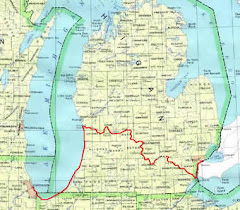.jpg)
Pioneers' tales of dugout canoes:
An advantage of the dugout for settlers was the log-canoe's ability to withstand being pushed and hauled over barriers in the upper rivers such as floodwood log jams, snags and shallows or riffles without unloading their cargo of potatoes or oats or whatever.
The following account is from an 1879 history of Branch County:
"Another event of the spring of 1830, which may, perhaps, be worth noticing, was the first attempt by white men to transport freight on the St. Joseph. J.W.Fletcher and John Allen went to Allen's Prairie in Hillsdale County, and bought ten bushels of seed potatoes and fifteen bushels of seed oats. They constructed two whitewood canoes, loaded in their oats and potatoes, ran down Sand Creek from the Prairie to the St. Joseph, and set out on a navigation of the latter stream.
Until they reached the mouth of the Coldwater, they found their way seriously impeded by shallow places, dams of floodwood, and similar obstacles. But they made basswood 'skids' on which they slid their canoes over the dams, while in the shallows they promptly jumped into the water, and each helped the other lighten his boat...Below the mouth of the Coldwater the water was high and the way clear, and they had no serious difficulties reaching their destination".
When sawmills to provide boards for boat building became widespread, pioneers built flat boats or arks to transport their goods and agricultural products. Meanwhile they used Indian-built dugouts or made their own.
In his paper "Indians of the Western Great lakes", author W.V.Kinietz describes Indian trails that parallel the Kalamazoo, Thornapple, Huron and Grand Rivers and adds: "The rivers, of course, were dotted with birchbark canoes and pirogues cut from whitewood logs."
Pioneer accounts often dwell on the instability of the craft: "...dugouts were made with great labor from Whitewood logs. They were very narrow and one inexperienced in handling them was sure to be capsized." Or, voyaging down the Looking Glass (another tributary of the Grand) in a "...dugout which shipped water at every slight turn and finally upset in the rapids..." Or "Deer and other game were frequently seen on the banks of the river, but the rocking of the canoes prevented the rifles of the navigators from furnishing them with venison."
* My take-off on Indiana's Tippecanoe River and the 1811 Battle of Tippecanoe.
In 1834, another party on the Looking Glass found a means to cope with the dugout's instability: "The men of the party at once began their construction and after several days of diligent work, completed two boats and a raft. The boats, commonly known as dugouts, were each made from a whitewood log, and were about eighteen feet long and two and one half feet wide. They were lashed together..."
On the St. Joseph, dugouts were sometimes sawed though lengthwise and widened by inserting boards.
In another pioneer history is an account about a settler on the Grand River near what is now Lansing: "He and some companions once employed some Indians to make them a canoe which they dug from a whitewood log. It was 44 feet long and 3 feet 2 inches inside. They paid the Indians 20 gallons of whiskey, and cheated them by watering it..."
Another Grand River valley pioneer recalled procuring "...a clumsy, square-toed white man's build of a canoe..."for the purpose of bringing home a supply of flour and pork. He describes the upstream journey: "I poled and Bennet pulled---that is he walked in the river or on shore ahead of the boat and towed with a rope while I poled."After days of struggle and about 40 river miles, they were both utterly exhausted and had to walk overland to get help to get it the rest of the way home.
Then there was the settler on the same river who floated his grain down steam to a grist mill and then made the return trip with the flour by hooking the dugout to a team of oxen with a log chain and pulling it cross-country through the woods back to his point of origin.Try that on your birchbark canoe---or your fiberglass canoe for that matter. The grist mill in this story was located at a spot about 450 yards downstream of my home on the Grand, within the view of Verlen Kruger's canoe base.
In these latter two accounts the pioneer didn't specifically say the dugouts were of whitewood, but I have assumed they were since Tuliptrees grew in the Grand River watershed and other stories about the Grand and the Looking Glass were about whitewood canoes.
NEXT: A ride with Indians and dugout construction.


No comments:
Post a Comment